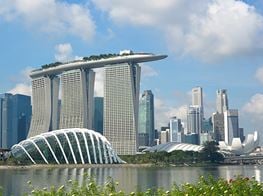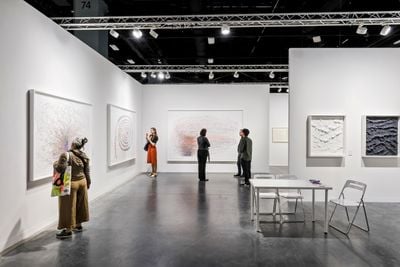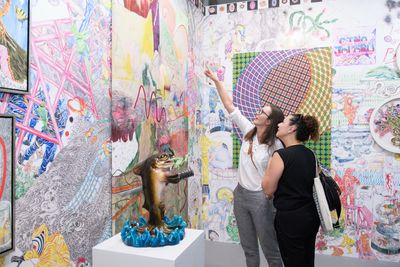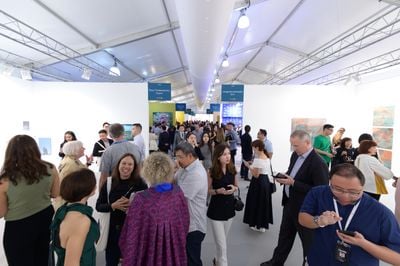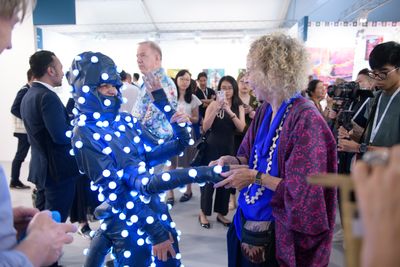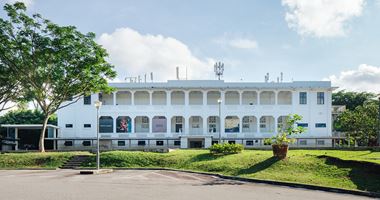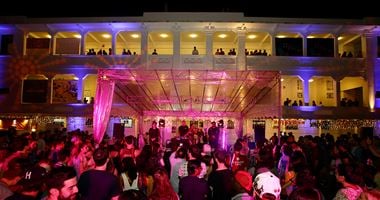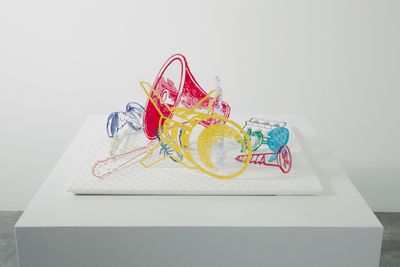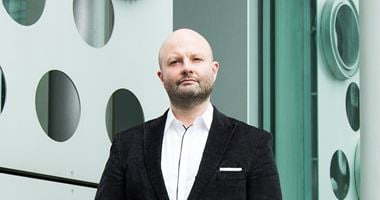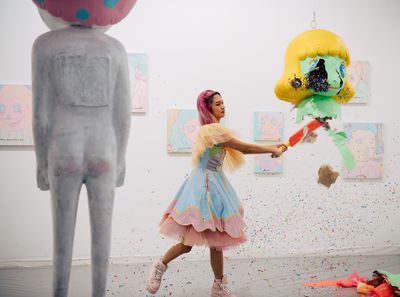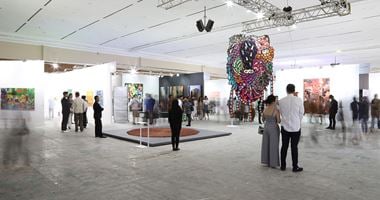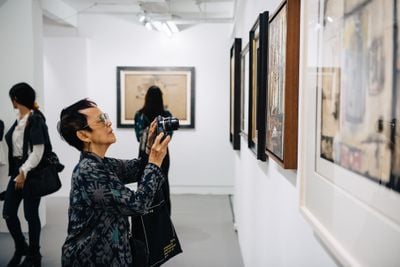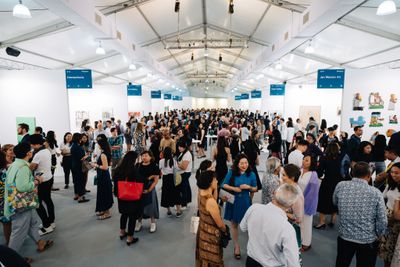Emi Eu: ‘We have to look at Southeast Asia as one market’
Emi Eu. Courtesy STPI – Creative Workshop & Gallery.
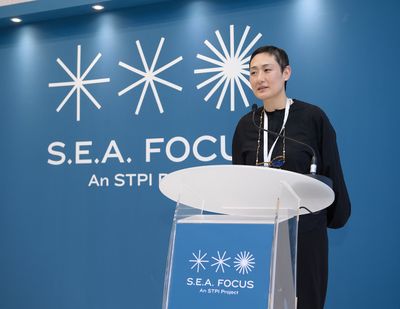
Emi Eu. Courtesy STPI – Creative Workshop & Gallery.
Emi Eu is the executive director of STPI – Creative Workshop & Gallery in Singapore, a not-for-profit organisation dedicated to facilitating artistic innovations in print and paper. STPI opened in 2002 under the umbrella of the Renaissance City Plan, unveiled by the government in 2000, which banked on Singapore becoming 'a key city in the Asian renaissance of the 21st century and a cultural centre in the globalised world.'1
Eu was recruited to work in the gallery in 2001 in anticipation of its public opening in 2002. She was appointed director in 2009, and is credited with expanding the organisation's international reputation as a space that pioneers both conceptual experimentation in print and paper and advances in technologies and techniques associated with the process. The institution's residency and exhibition programme invites mid-career artists from across the world to experiment in paper: they include Lee Bul, Teresita Fernández, Shirazeh Houshiary, Lin Tianmiao, Ashley Bickerton, and many others. The results of these residencies can be seen at all three Art Basel fairs: having shown with ArtHK before it became Art Basel Hong Kong, STPI became the first Singaporean gallery to participate at Art Basel in Basel in 2013, followed by Art Basel Miami Beach in 2014. Eu herself is a member of the Selection Committee of Art Basel in Hong Kong.
With support from the National Arts Council, STPI launched S.E.A. Focus in 2019 at Gillman Barracks: a curated platform showcasing galleries and artists from across Southeast Asia that is positioned as a focal point of Singapore Art Week. Billed as 'a meeting point' that aims 'to propel diverse cultural exchanges which celebrate, promote and provoke dialogue about Southeast Asian art', the second edition of S.E.A. Focus was held from 16 to 19 January 2020—one year after the abrupt cancellation of Art Stage Singapore in 2019 just as S.E.A. Focus held its inaugural edition. Twenty galleries presented curated showcases this year, including works by recent STPI residents Melati Suryodarmo and Pinaree Sanpitak at STPI's dedicated booth, with former STPI residents spotted elsewhere. Rirkrit Tiravanija's interactive installation untitled 2019 (beauté esthétique with no shampoo) (2019) at neugerriemschneider invited visitors to drink cool green tea amid walls covered in cobalt blue silk-screened images of protest. Works by Danh Vō at Vitamin Creative Space—including two copies of French Catholic missionary Saint Théophane Vénard's letter to his father before his 1861 decapitation in Vietnam, copied by Vō's father as part of the '2.2. 1861' series (2009–ongoing)—were arranged in a booth whose floors were stripped of carpeting to reveal wooden boards.
Even if you combine the whole Southeast Asian market, it is still small, and I think that is the main reason why S.E.A. Focus is being used as a vehicle or catalyst: to propel what is happening in Southeast Asia to get some attention from the international market.
In this conversation, Emi Eu, who first came to Singapore in 1996, reflects on the relationship between STPI and S.E.A. Focus within the broader scope of a state-supported vision for art and culture in Singapore, looking at how the Singapore art scene has developed, the impact of Art Stage, and what the future holds with the launch of Art SG in October 2020, a new art fair by Tim Etchells, Sandy Angus, and Magnus Renfrew.
SBI wanted to start with the fall of Art Stage in 2019, which happened just as S.E.A. Focus launched its inaugural edition—quite a dramatic moment for Singapore's art scene. Did this influence the planning of S.E.A. Focus in 2020, or in any way reroute the initial vision that you had for the project?
EEThe genesis of S.E.A. Focus really came out of the Art Galleries Association Singapore (AGAS). AGAS was established in 1996, and the founding members felt that an art show by the galleries should happen. The members started a fair called Art Singapore, but it became too much to organise every year, so they gave it to a colleague and she ran it until 2008—for ten good years, until she had to close it because of the financial crisis. So that was the genesis of an art show in Singapore. The arts of Singapore died down after that, and AGAS was kind of a dormant association until Gillman Barracks started to invite galleries and STPI became much more active.
I took office at AGAS with a few members, and every year our biggest concern was what we were going to do; we needed to do something for the members and enliven and reenergise the whole arts landscape in Singapore. The National Gallery was being built, so things were happening. We went to agencies asking for money to open an office and to hire people. Then the National Arts Council said, 'Hey AGAS, if you really want to do this, we can support you, but could you do it in a much bigger way?' So we said OK. This is something that we always wanted to do for the galleries in Singapore. It had nothing to do with Art Stage—we thought it would complement Art Stage, to make the Art Week a lot more interesting. It was not a competition, but at the same time, if you remember the last few iterations of Art Stage, you could really see that it was declining. The numbers were going down and the content was a bit fatigued compared to earlier editions of the fair, but we always supported Art Stage because it was such a vital player within the Singapore arts ecosystem.
This is how the idea of S.E.A. Focus sprouted. Last year, we were catapulted into the spotlight because of this drama, and then the whole town came out to support showing such a strong collaborative spirit. I was very nervous yesterday because I wondered if there would be the same kind of support this year. The entire STPI Gallery was activated this year. Last year, we worked with Audrey from Yeo Workshop on this project.
SBOne of the reasons that Art Stage director Lorenzo Rudolf gave for the cancellation of that fair was that there was no market in Singapore. I'm interested in the fact that S.E.A. Focus doesn't take a position as an art fair, even if it is a marketplace. What are the challenges of developing a viable selling platform in Singapore? Is there really no market?
EEFor an art market to thrive and be sustainable, the responsibility does not have to be taken by one party. If you go to the most established art markets, for example in Basel; Art Basel takes such a huge position, but if you really look carefully, the institutions play a large part in that week too. For any art market to thrive, you've got to have everybody working together, and that's what we call an arts ecosystem or arts landscape.
I don't like to say that Singapore's market is small—the point is, we have to look at Southeast Asia as one market. The fact is that these kinds of events take place in Singapore because we have the infrastructure, and I do think that Singapore has all the elements needed to have a good arts ecosystem, so this seems to be the natural place. Also, it's a multicultural city. English is spoken much more widely here, even if you compare it with Hong Kong, so it's much easier for foreigners to navigate the city. Even if you combine the whole Southeast Asian market, it is still small, and I think that is the main reason why S.E.A. Focus is being used as a vehicle or catalyst: to propel what is happening in Southeast Asia to get some attention from the international market.
SBWhat's so interesting about STPI, and about S.E.A. Focus being an STPI project, is how it sits within government initiatives for establishing Singapore as a global art hub. Since the National Arts Council was founded, those initiatives have been focused on using art and culture as a form of nation-building. I wondered if you could speak a little bit about this, as it relates to the hybridity of STPI as a not-for-profit yet selling platform: a public-private model just like S.E.A. Focus.
EEThis relates to a much deeper conversation that we need to have about Singapore as a nation. I'm not a Singaporean, but I married into a Singaporean family and have been living here for 20 years. I grew up in South Korea and the States, then I lived for some time in Europe, so I had glimpses of different continents before settling here. Singapore is a country that is only 52 years old. There are no natural resources here, so from the very start, the government has had to figure out how the country is going to survive, and the ethos has been to innovate and to do things that nobody has ever done.
I think it was a shock in the beginning, when we came out as a non-profit space with a commercial gallery; but now, if you look at the art world, there are no more boundaries, everybody's doing everything.
STPI Gallery is like a museum shop, but in a different format. We know that all non-profit organisations in Singapore need to bring in some kind of funding, it's just that STPI has larger and more substantial things to sell. When the government approved the establishment of STPI, they didn't know much about contemporary art, or the market. They weren't going to spend money on contemporary art pieces, although if they did, they would have made much more money. We have huge holdings of Kenneth Tyler's collection, of 1,200 pieces, which have gone up in value tremendously, so they would still make money if they were to sell those back—there are works by Hockney, Rosenquist, Stella, Motherwell, Mitchell, and more.
The government thought STPI could be a catalyst to create an art scene on a fast track—they wanted to make sure that Singapore became a global city, for this region and beyond. There is the Renaissance City Plan, which is now in its third phase, which I believe is really focused on the environment. STPI was in the second phase. The thought leadership of the government is really incredible—they work in a very planned, methodical way. I think it was a shock in the beginning, when we came out as a non-profit space with a commercial gallery; but now, if you look at the art world, there are no more boundaries, everybody's doing everything.
SBWhat challenges does this proximity between the government and the arts infrastructure in Singapore create?
EEWe are given government support with the STPI building, and real estate takes a big chunk of the expenses on the operating budget. We were given these premises for free, which helps tremendously, and they give us nominal cash funding to cover the utilities, but the rest is made up by the sales and fundraisers that we do in the gallery, and everything else. We have to work hard to get the money.
SBDo you feel like you operate independently? Or is there a sense of a hovering nanny state?
EEWe are completely independent, and I think that's why we were able to come this far—they've just left us alone. I've been doing the artists' programming since the beginning and I've had no interference from anyone. We do have a board that is very supportive, and I've had an incredible board from the very beginning—I've been really lucky.
SBThere is a lot of innovation happening at STPI: there's the work that artists create and the technicians who facilitate their experimentation, and the workshop facilities and techniques developed in the process, from the 500-tonne press in STPI's workshop that Kenneth Tyler made by converting a car compactor machine, to the vacuum table that was developed to minimise water waste. Could you talk about the innovations that have been pioneered here?
EEYes, we have made a tremendous amount of innovations in the way artists work, and every project comes out with new ideas. My board is pressing me to register the intellectual properties of this, but it seems kind of hard because it's a collaborative effort between the artists and our team, and we would have to register the process, not the final result. When Kenneth Tyler set this place up, he had a grand vision, and we are indebted to him to have the workshop, gallery, artist studio, and artist apartment all in one building. He designed the entire layout as a one-stop shop.
I see S.E.A. Focus as a vehicle to work with different parties and put the pieces of the puzzle together to make a more solid foundation and allow other things to happen.
At the beginning, we had a lot of challenges bringing artists from abroad. If you look at our wall of artist names, you can see the changes in participation. It took great effort to bring all these artists in, but I think the turning point was when we started working with the Asia Society for their 50th anniversary, with all the artists who were really active in 2005, and with Ashley Bickerton, so we were making inroads very slowly. With every artist, something different comes up in the workshop. For example, this year we are making paper with cement. We made paper with rocks that the Chinese artist, Zhang Wang smashed. We work a lot with paper, and paper becomes a main protagonist with a lot of artists' projects.
SBThinking about STPI as a space that allows mid-career artists to innovate their practices, how might S.E.A. Focus be an innovator as a selling platform that seeks to be more than that? How might it innovate gallery and collecting practices?
EEI think this question is not specific to Southeast Asia or S.E.A. Focus; it's something that the whole art world is asking. So many things are happening—the art world changes every quarter. It's very fast paced now, and we don't have any down time—it just goes on at full force, all the time. I see S.E.A. Focus as a vehicle to work with different parties and put the pieces of the puzzle together to make a more solid foundation and allow other things to happen. I don't see S.E.A. Focus as the primary innovator, but more like a thought leader that can activate other parties to come together and innovate.
This year, we have an advisory committee of four members, and we will get together after seeing the project to brainstorm what to do next. Fair people expect the same format every year, but I want people to think out of the box. S.E.A. Focus can take any form. We have to keep moving and evolving with what is happening in our world; we can't just be stagnant. The first edition of Art SG is coming in October, and that will be a very important platform as well. We want to support Magnus [Renfrew]. Yes, it is a completely private, commercial venture, but it is somewhat necessary. A one-stop shop art week with an art fair, it's nice as it gives people the reason to come here, but what else is there? We need to be prepared for what is to come. I don't want to put S.E.A. Focus in that fair format. I put a lot of effort in the content of the S.E.A. Focus talks programme, as we need to hear what is happening in the markets of other countries.
SBI'm curious about how you work with all of your stakeholders, because you have to manage expectations when it comes to the platform and its commercial viability, right? How do you get the galleries on board?
EERight now, it's at such a preliminary stage; we're taking baby steps. There are a lot of personal relationships involved, but hopefully the galleries will see that S.E.A. Focus can offer something different or something more.
S.E.A. Focus is not a competitor to any of these art fairs: Art Jakarta, Art SG, or Art Basel Hong Kong. S.E.A. Focus is going to be an activator and a thought leader in what is out there for Southeast Asia
First, galleries are able to meet new people or forge even stronger relationships with buyers and collectors. Usually, there's no time for galleries to really sit down and have a chat with their collectors and to let them know what they're doing. I bumped into some people at this edition of S.E.A. Focus who said they hadn't been able to get through the fair, and I said, 'What are you talking about, there are only 20 galleries!' And they said, 'But there's so much to see!' That means people are spending time to really understand, and that was my goal. I was so happy to hear that, because the reason why I encourage galleries to bring only one or two artists max is that I want people to really understand an artist's practice in a deeper way. If you have so many artists, it's very superficial, and that's why I really wanted the gallery section of the fair to be a place where people spend time. We have that luxury here in Singapore; we may not have that in Basel, New York, or Paris, but here I feel we can afford that.
SBI suppose the luxury of time relates to how government involvement helps.
EEYes, it does help. You can see on our logo wall that we've also got a lot of partnerships from the private sector. That's also a very important message. We wanted to give the message that we have tremendous support from the private sector—my project team worked so hard over the Christmas holidays and leading up to this to get as many partners as possible.
SBSo the more intricate the network of supporters, the more independent the platform can become, because STPI becomes the mediator of all parties involved in supporting the project.
EEExactly. We don't want to be held accountable by the government. We want to be independent from that within our parameters and boundaries as much as possible.
SBCan we expect a change in format after Art SG comes to town?
EEYes, I want to be able to support Art SG. S.E.A. Focus is not a competitor to any of these art fairs: Art Jakarta, Art SG, or Art Basel Hong Kong. S.E.A. Focus is going to be an activator and a thought leader in what is out there for Southeast Asia to close the gap, or to find the gap to close, and to create a more uniform and harmonised market that is easier to understand. For people from America or Europe, Southeast Asia is still seen as an exotic, mystical place for holidays—they don't really think, 'Oh I'm going to go there to see what's happening in the contemporary art scene.' We want to work with that to lure them in, but to really find something more substantial and that they may like, and then be very friendly. It's all about familiarity.
SBWe started by discussing the Art Galleries Association Singapore, which was founded in 1996, the same year you first came to Singapore. This gives you a very broad, overarching perspective of how Singapore's arts ecosystem has evolved. What would you say are some of the most striking developments that you've seen so far?
EEIn the last 20 years, since I first arrived, I specifically remember going to Singapore Art Museum and seeing Georgette Chen's exhibition, who is now considered as one of the modern masters. That was the first time I had seen work from this part of the world. I was living in Paris previously, and I noticed in the style of her work that she must have been in Paris, which was a very interesting connection, but I was still unfamiliar with the art here. There has been tremendous progress since then.
A lot of people may see the government's involvement in the arts as a bad thing, but in a region like this, it is a positive thing, because then we can have a standpoint to make it better. There's so much more work to do, but it is really amazing to see all the different parts of this ecosystem working so hard. Somebody was asking me about the censorship, and then I was like, 'In Thailand, one has to be so careful when referring to the royal family!' Yes, I can understand that censorship here was tremendously hard in the beginning, but I really think the Singapore government does understand—we just have to be mindful and be respectful of that. They leave us to do what we need to do.
SBIt's a work in progress, just like the nation-state itself.
EEIt is a work in progress.
SBThat's what I've understood: one of the government's main aims is to create a cohesive Singapore because this is a young, multicultural society, which is why investing in art and culture is so important.
EEThat is the main priority for the government—to create a cohesive Singapore, with religions that come from all different places, especially when there's so much conflict between these religions outside the country. They want to create a safe place, an ideal city—they put tremendous effort in creating pleasant, habitable, wonderful places for people to live in. I can't fault it for that. —[O]
—

